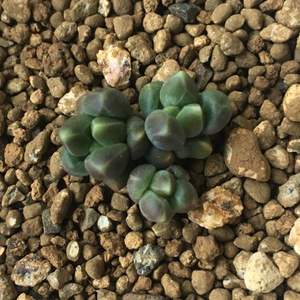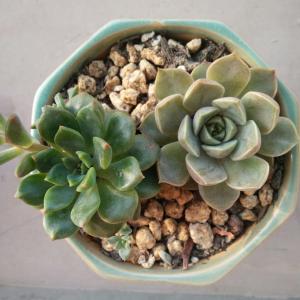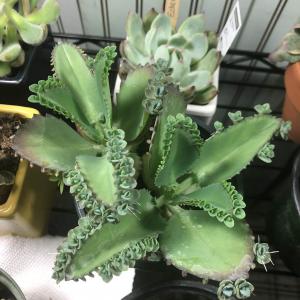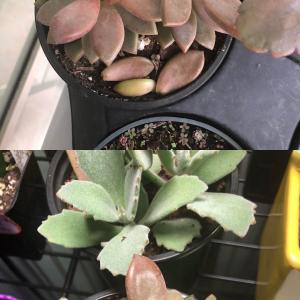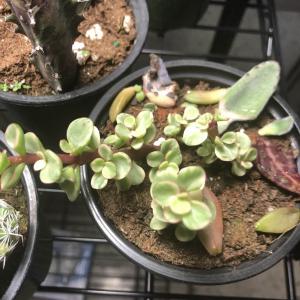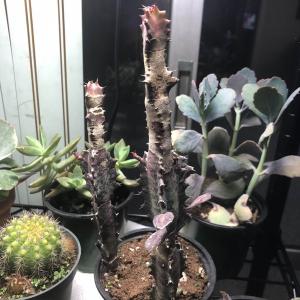成长记
Koala小熊
2018年06月10日

不知不覺接觸多肉植物也滿一年了
去年的6/9把小熊童子帶回來養
中間經過修剪和移盆
現在已經長這麼大了
希望可以平安度過這個夏天
熊童子 生日快樂唷~~~(^^)
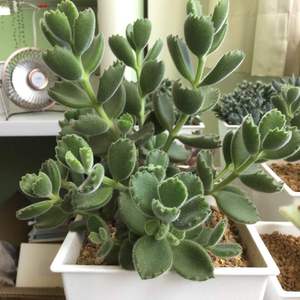
去年的6/9把小熊童子帶回來養
中間經過修剪和移盆
現在已經長這麼大了
希望可以平安度過這個夏天
熊童子 生日快樂唷~~~(^^)

2
0
新手琪琪😊:你種得很美,不知道為甚麼我的又瘦又扁哦😞
文章
Miss Chen
2018年05月27日

Description: This perennial wildflower develops an erect stem about 2-8" tall that has a whorl of 5-9 leaves at its apex. The stem is light green (sometimes tinted yellow or red), terete, glabrous, and relatively slender. The stems are either naked, or they have a few scale-like leaves that are inconspicuous. The larger whorled leaves at the apex are 1-4" long and ¼-1½" across; they are more or less medium green, lanceolate-elliptic to oblong-elliptic in shape, relatively smooth along their margins, and glabrous. These latter leaves taper gradually to acute tips, while their bases are narrowly wedge-shaped; they are either short-petioled or sessile. In each whorl, these leaves can vary significantly in size. Leaf venation is pinnate.
From the center of the whorled leaves, there develops 1-3 flowers on erect or ascending pedicels. The pedicels are ¾-2½" long, terete, light green (sometimes tinted yellow or red), glabrous, and slender. Each flower is about ½-¾" across, typically consisting of 7 white spreading petals, 7 light green sepals, 7 stamens with pale yellow anthers, and a light green ovary with a single white style. However, a flower can have as few as 5 petals, sepals, and stamens, or as many as 9. The petals are lanceolate-elliptic in shape, while the sepals are linear-lanceolate and glabrous. The petals are longer than the sepals. The blooming period is mid-spring to early summer (in Illinois & neighboring areas), lasting about 2-4 weeks. Afterwards, the flowers are replaced by ovoid seed capsules that are 5-celled; they are shorter than the sepals. These capsules eventually split open to release their seeds. The root system is rhizomatous and fibrous; the rhizomes are slender and long.
Cultivation: The preference is light shade or dappled sunlight, moist conditions, an acidic soil containing peat and/or sand, and cool summer temperatures.

Range & Habitat: The native Starflower is rare in Illinois and state-listed as 'threatened.' It is restricted to the northern section of the state (see Distribution Map). Illinois lies along the southern range-limit of this species. Habitats include tamarack bogs, birch bogs, hummocks in sandy swamps, edges of sandy woodlands along swamps, and ravines leading out of bluffs. This wildflower is found in high-quality natural areas where either coniferous or deciduous trees are present.
Faunal Associations: Records of floral-faunal relationships for Starflower (Trientalis borealis) are sparse. The flowers attract Halictid bees, Andrenid bees (Andrena spp.), and Syrphid flies. All of these insects either collect or feed on pollen, as the flowers do not produce nectar. The Eastern Chipmunk sometimes eats the seeds/capsules of this wildflower. It is possible that other small rodents do this as well.

Photographic Location: A moist woodland along the edge of a sandy swamp in NW Indiana.
Comments: This delicate wildflower is unusual because it typically has 7-petaled flowers. The flowers of Starflower superficially resemble those of one of the showier chickweeds (e.g., Stellaria pubera), except their petals are usually more numerous and they are located above a conspicuous whorl of leaves. Two other species in the Trientalis genus have been described, but they don't occur in Illinois. One species from the Pacific northwest of North America, Trientalis latifolia, has pinkish flowers rather than white, while a European species, Trientalis europaea, has pedicels that are usually longer than the leaves. A more specific common name of Trientalis borealis is Northern Starflower.
From the center of the whorled leaves, there develops 1-3 flowers on erect or ascending pedicels. The pedicels are ¾-2½" long, terete, light green (sometimes tinted yellow or red), glabrous, and slender. Each flower is about ½-¾" across, typically consisting of 7 white spreading petals, 7 light green sepals, 7 stamens with pale yellow anthers, and a light green ovary with a single white style. However, a flower can have as few as 5 petals, sepals, and stamens, or as many as 9. The petals are lanceolate-elliptic in shape, while the sepals are linear-lanceolate and glabrous. The petals are longer than the sepals. The blooming period is mid-spring to early summer (in Illinois & neighboring areas), lasting about 2-4 weeks. Afterwards, the flowers are replaced by ovoid seed capsules that are 5-celled; they are shorter than the sepals. These capsules eventually split open to release their seeds. The root system is rhizomatous and fibrous; the rhizomes are slender and long.
Cultivation: The preference is light shade or dappled sunlight, moist conditions, an acidic soil containing peat and/or sand, and cool summer temperatures.

Range & Habitat: The native Starflower is rare in Illinois and state-listed as 'threatened.' It is restricted to the northern section of the state (see Distribution Map). Illinois lies along the southern range-limit of this species. Habitats include tamarack bogs, birch bogs, hummocks in sandy swamps, edges of sandy woodlands along swamps, and ravines leading out of bluffs. This wildflower is found in high-quality natural areas where either coniferous or deciduous trees are present.
Faunal Associations: Records of floral-faunal relationships for Starflower (Trientalis borealis) are sparse. The flowers attract Halictid bees, Andrenid bees (Andrena spp.), and Syrphid flies. All of these insects either collect or feed on pollen, as the flowers do not produce nectar. The Eastern Chipmunk sometimes eats the seeds/capsules of this wildflower. It is possible that other small rodents do this as well.

Photographic Location: A moist woodland along the edge of a sandy swamp in NW Indiana.
Comments: This delicate wildflower is unusual because it typically has 7-petaled flowers. The flowers of Starflower superficially resemble those of one of the showier chickweeds (e.g., Stellaria pubera), except their petals are usually more numerous and they are located above a conspicuous whorl of leaves. Two other species in the Trientalis genus have been described, but they don't occur in Illinois. One species from the Pacific northwest of North America, Trientalis latifolia, has pinkish flowers rather than white, while a European species, Trientalis europaea, has pedicels that are usually longer than the leaves. A more specific common name of Trientalis borealis is Northern Starflower.
0
0
文章
Miss Chen
2018年05月22日

Description: This wildflower consists of a rosette of basal leaves and a flowering stalk about 1-3' tall. Individual basal leaves are up to 9" long and 3" across; they are oblong to ovate-oblong, crenate or smooth along their margins, and medium green. Basal leaves are glabrous to sparsely hairy on their upper surfaces, while their lower surfaces are sparsely to moderately hairy. Generally, young leaves are more hairy than older leaves. The inflorescence consists of a panicle of flowers, which develops from an erect central stalk. This stalk is fairly stout, terete, and densely covered with spreading hairs. The panicle is ellipsoid in shape, ½–1½' long, and about 1/3 as much across when it is fully extended. The branches of the panicle are ascending to spreading and usually pubescent. There is a single linear-lanceolate bract at each major fork of the branches. Depending on the size of the inflorescence, the flowers vary in abundance; they usually bloom at about the same time. Each flower is ¼" across, consisting of 5 narrow white petals, 5 green sepals that are joined together at the base, 10 stamens with white to orange-brown anthers, and 2 prominent pistils that are green and joined together. The sepals are triangular in shape and become recurved when the flowers bloom. The petals are longer than the sepals. The blooming period occurs during the late spring for 2-3 weeks. Each flower is replaced by a pair of beaked follicles; each follicle splits open along one side to release its seeds. The root system consists of a crown of fleshy fibrous roots and rhizomes. Clonal offsets from the rhizomes are often formed.
Cultivation: The preference is light shade to partial sun, consistently moist conditions, high humidity, and thin rocky soil containing sandstone. The site should be protected from prevailing winds.
Range & Habitat: The native Forbe's Saxifrage is found in southern Illinois (where it is uncommon) and 3 counties in northern Illinois, where it is rare; it is absent from the remaining areas of the state (see Distribution Map). This map excludes the distribution of the more common typical variety, Saxifraga pensylvanica pensylvanica (Swamp Saxifrage). Habitats are largely restricted to the lower slopes of rocky bluffs (usually north-facing), moist ledges along sandstone ravines, and the lower slopes of sandstone canyons, particularly where some seepage of moisture occurs. These habitats are always found in wooded areas with varying amounts of shade. Forbe's Saxifrage is restricted to high quality natural areas.
Faunal Associations: The flowers are cross-pollinated primarily by small bees, wasps, and various flies. Less common visitors include sawflies and beetles. These insects usually suck nectar, although some of the bees also collect pollen, while some flies and beetles prefer to feed on the pollen. These observations are from Graenicher.
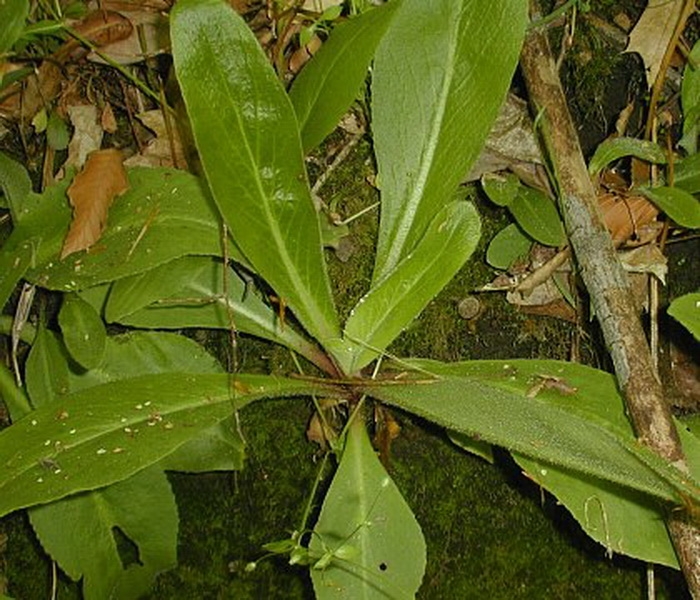
Photographic Location: Lower slope of a sandstone canyon at the Portland Arch in west-central Indiana.
Comments: I have selected Vasey's taxonomic classification of Forbe's Saxifrage. This is something of a compromise. Some botanists in Illinois and Indiana (e.g., Mohlenbrock, 2002) classify Forbe's Saxifrage as a separate species, Saxifraga forbesii, rather than a variety of Saxifraga pensylvanica (Swamp Saxifrage). Other botanists don't recognize Forbe's Saxifrage at even the varietal level. Generally, Forbe's Saxifrage is supposed to have hairier basal leaves than Swamp Saxifrage, and the petals of its flowers are longer than the sepals. Swamp Saxifrage is supposed to have slightly smaller flowers, where the petals are about the same length as the sepals. Swamp Saxifrage is found primarily in the northern half of Illinois, where it is found in both sunny and shaded wetlands. The only other Saxifrage in Illinois is Saxifraga virginiensis (Early Saxifrage), which has been found only in Hardin County. This latter species is much smaller in size; it prefers drier upland areas and can bloom as early as mid-spring.
Cultivation: The preference is light shade to partial sun, consistently moist conditions, high humidity, and thin rocky soil containing sandstone. The site should be protected from prevailing winds.
Range & Habitat: The native Forbe's Saxifrage is found in southern Illinois (where it is uncommon) and 3 counties in northern Illinois, where it is rare; it is absent from the remaining areas of the state (see Distribution Map). This map excludes the distribution of the more common typical variety, Saxifraga pensylvanica pensylvanica (Swamp Saxifrage). Habitats are largely restricted to the lower slopes of rocky bluffs (usually north-facing), moist ledges along sandstone ravines, and the lower slopes of sandstone canyons, particularly where some seepage of moisture occurs. These habitats are always found in wooded areas with varying amounts of shade. Forbe's Saxifrage is restricted to high quality natural areas.
Faunal Associations: The flowers are cross-pollinated primarily by small bees, wasps, and various flies. Less common visitors include sawflies and beetles. These insects usually suck nectar, although some of the bees also collect pollen, while some flies and beetles prefer to feed on the pollen. These observations are from Graenicher.

Photographic Location: Lower slope of a sandstone canyon at the Portland Arch in west-central Indiana.
Comments: I have selected Vasey's taxonomic classification of Forbe's Saxifrage. This is something of a compromise. Some botanists in Illinois and Indiana (e.g., Mohlenbrock, 2002) classify Forbe's Saxifrage as a separate species, Saxifraga forbesii, rather than a variety of Saxifraga pensylvanica (Swamp Saxifrage). Other botanists don't recognize Forbe's Saxifrage at even the varietal level. Generally, Forbe's Saxifrage is supposed to have hairier basal leaves than Swamp Saxifrage, and the petals of its flowers are longer than the sepals. Swamp Saxifrage is supposed to have slightly smaller flowers, where the petals are about the same length as the sepals. Swamp Saxifrage is found primarily in the northern half of Illinois, where it is found in both sunny and shaded wetlands. The only other Saxifrage in Illinois is Saxifraga virginiensis (Early Saxifrage), which has been found only in Hardin County. This latter species is much smaller in size; it prefers drier upland areas and can bloom as early as mid-spring.
0
0
文章
Miss Chen
2018年05月19日

Description: This perennial wildflower typically consists of a cluster of unbranched erect stems about 3-9" tall. These stems are terete, white (sometimes tinted pink), translucent, fleshy, and hairless. The alternate leaves are scale-like and small; like the stems, they are white, translucent, and hairless. Each stem terminates in a single white flower about ½–¾" long that is nodding to nearly erect; this flower is narrowly bell-shaped, consisting of 2-4 sepals and 4-5 petals. The petals are longer and more persistent than the sepals. Within the interior of the flower, there are 10-12 stamens surrounding a stout style. The time of year when flowers are produced can be highly variable, extending from late spring into the fall. However, the blooming period for individual plants lasts only 1-2 weeks. The flowers produce no obvious floral scent. After the blooming period, the entire plant becomes dark brown or black, and each flower is replaced by an erect ovoid seed capsule about ½" long. This seed capsule is 5-celled and contains numerous tiny seeds, which are easily blown about by the wind after the capsule splits open. The root system consists of a mat of brittle fleshy roots. This wildflower is saprophytic and lacks chlorophyll in its tissues; it forms either a symbiotic or parasitic association with mycorrhizal fungi through its roots.
Cultivation: Cultivating Indian Pipe is very difficult, if not impossible; plants that are transplanted from the wild are highly unlikely to survive. Abundant woodland humus and the presence of appropriate fungi are required for survival. Because Indian Pipe does not rely on photosynthesis, it can adapt to deep shade.
Range & Habitat: Indian Pipe can be found at scattered sites throughout Illinois (see Distribution Map). In Illinois, habitats are largely restricted to rich deciduous woodlands in areas with abundant humus. These woodlands are typically dominated by either maples or oaks. Indian Pipe also occurs in woodlands where coniferous trees are present. This unusual wildflower is normally found in high quality woodlands.
Faunal Associations: Information about floral-faunal relationships for this species is very limited. The flowers are cross-pollinated by long-tongued bees; such insects probably seek nectar. Bears may feed on the plants when they develop above the ground surface, or they may dig up and feed on the root mass (the latter behavior has been observed for Grizzly Bears in British Columbia). Indian Pipe is not known to be toxic.

Photographic Location: The photographs (Copyright © 2008) were taken by Paul and London Showers near Wilmot Woods in Lake County, Illinois.
Comments: Because of its ghostly white appearance, some people may confuse Indian Pipe for a fungus. This species belongs to a small group of saprophytic flowering plants that have abandoned photosynthesis. A similar species, Monotropa hypopithys (Pinesap), also occurs in Illinois, but it is less common. Unlike Indian Pipe, Pinesap produces several nodding flowers on each stem; these flowers are arranged in a short raceme. Pinesap is more likely to be tinted different colors (including bright red), and it is often pubescent.
Cultivation: Cultivating Indian Pipe is very difficult, if not impossible; plants that are transplanted from the wild are highly unlikely to survive. Abundant woodland humus and the presence of appropriate fungi are required for survival. Because Indian Pipe does not rely on photosynthesis, it can adapt to deep shade.
Range & Habitat: Indian Pipe can be found at scattered sites throughout Illinois (see Distribution Map). In Illinois, habitats are largely restricted to rich deciduous woodlands in areas with abundant humus. These woodlands are typically dominated by either maples or oaks. Indian Pipe also occurs in woodlands where coniferous trees are present. This unusual wildflower is normally found in high quality woodlands.
Faunal Associations: Information about floral-faunal relationships for this species is very limited. The flowers are cross-pollinated by long-tongued bees; such insects probably seek nectar. Bears may feed on the plants when they develop above the ground surface, or they may dig up and feed on the root mass (the latter behavior has been observed for Grizzly Bears in British Columbia). Indian Pipe is not known to be toxic.

Photographic Location: The photographs (Copyright © 2008) were taken by Paul and London Showers near Wilmot Woods in Lake County, Illinois.
Comments: Because of its ghostly white appearance, some people may confuse Indian Pipe for a fungus. This species belongs to a small group of saprophytic flowering plants that have abandoned photosynthesis. A similar species, Monotropa hypopithys (Pinesap), also occurs in Illinois, but it is less common. Unlike Indian Pipe, Pinesap produces several nodding flowers on each stem; these flowers are arranged in a short raceme. Pinesap is more likely to be tinted different colors (including bright red), and it is often pubescent.
0
0
成长记
Koala小熊
2018年05月16日

將近9個月大
窗台上最近都會到30多度
雖然只有早上9:30前和下午4:30後會有直射陽光
希望旋葉姬星美人可以度過接下來炎夏的考驗(^^)
P.S. 似乎可以來把突出盆外的分支剪下來繁殖了

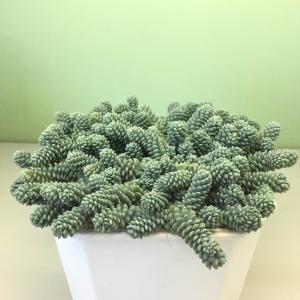
窗台上最近都會到30多度
雖然只有早上9:30前和下午4:30後會有直射陽光
希望旋葉姬星美人可以度過接下來炎夏的考驗(^^)
P.S. 似乎可以來把突出盆外的分支剪下來繁殖了


0
0



